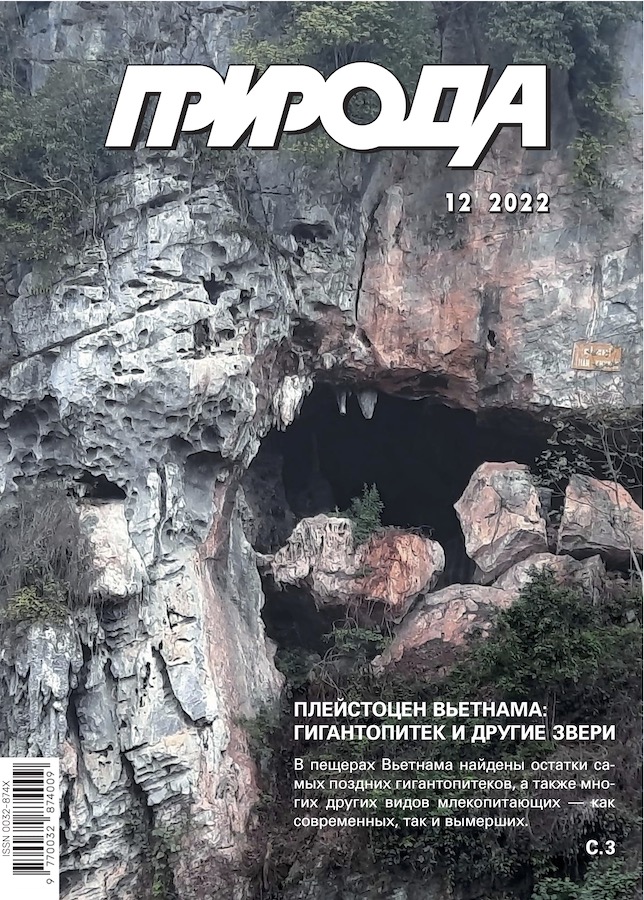2022 Nobel Prize Laureate in Physiology or Medicine: Svante Pääbo
- 作者: Borinskaya S.A1, Markina N.V1
-
隶属关系:
- Vavilov Institute of General Genetics, Russian Academy of Sciences
- 期: 编号 12 (2022)
- 页面: 50-57
- 栏目: Articles
- URL: https://journals.eco-vector.com/0032-874X/article/view/627723
- DOI: https://doi.org/10.7868/S0032874X22120067
- ID: 627723
如何引用文章
详细
The 2022 Nobel Prize in Physiology or Medicine has been awarded to Svante Pääbo, a pioneer in paleogenetic research “for his discoveries concerning the genomes of extinct hominins and human evolution”. Svante Pääbo significantly contributed to the development of methods for studying ancient DNA. The discoveries of Pääbo and his team clarify the modern view on the evolution of Homo sapiens and its relationship with other extinct Homo species, provide possibilities to reconstruct the lifestyle features of ancient people, and contribute to paleontology, paleoecology, and medicine. The award recognizes not only the personal scientific merits of Svante Pääbo, but also the entire field of paleogenetics, which for many years was thought to be of no practical value, but only used to lift the veil on the ancient events of the genetic history of mankind.
作者简介
S. Borinskaya
Vavilov Institute of General Genetics, Russian Academy of Sciences
Email: borinskaya@vigg.ru
Moscow, Russia
N. Markina
Vavilov Institute of General Genetics, Russian Academy of SciencesMoscow, Russia
参考
- Meyer M., Briggs A.W., Maricic T. et al. From micrograms to picograms: quantitative PCR reduces the material demands of high-throughput sequencing. Nucleic Acids Res. 2008; 36(1): e5. doi: 10.1093/nar/gkm1095.
- Pääbo S. Molecular cloning of Ancient Egyptian mummy DNA. Nature. 1985; 314: 644–645. doi: 10.1038/314644a0.
- Del Pozzo G., Guardiola J. Mummy DNA fragment identified. Nature. 1989; 339: 431–432. doi: 10.1038/339431b0.
- Callaway E. From Neanderthal genome to Nobel prize: meet geneticist Svante Pääbo. Nature. 2022; Oct 7. doi: 10.1038/d41586-022-03191-9.
- Saiki R.K., Scharf S., Faloona F. et al. Enzymatic amplification of beta-globin genomic sequences and restriction site analysis for diagnosis of sickle cell anemia. Science. 1985; 230(4732): 1350–1354. doi: 10.1126/science.2999980.
- Pääbo S., Higuchi R.G.,Wilson A.C. Ancient DNA and the polymerase chain reaction. The emerging field of molecular archaeology. J. Biol. Chem. 1989; 264(17): 9709–9712. doi: 10.1016/S0021-9258(18)81710-0.
- Krings M., Stone A., Schmitz R.W. et al. Neanderthal DNA sequences and the origin of modern humans. Cell. 1997; 90: 19–30. doi: 10.1016/S0092-8674(00)80310-4.
- Gibbons A. Human evolution. Neandertals and moderns made imperfect mates. Science. 2014; 343(6170): 471–472. doi: 10.1126/science.343.6170.471.
- Пэабо С. Неандерталец. В поисках исчезнувших геномов. Наймарк Е. (пер. с англ.) М., 2018. [Pääbo S. Neanderthal Man: In Search of Lost Genomes. Hachette UK, 2014.]
- Green R.E., Krause J., Briggs A.W. et al. A draft sequence of the Neandertal genome. Science. 2010; 328(5979): 710–722. doi: 10.1126/science.1188021.
- Krause J., Fu Q., Good J.M. et al. The complete mitochondrial DNA genome of an unknown hominin from southern Siberia. Nature. 2010; 464(7290): 894–897. doi: 10.1038/nature08976.
- Meyer M., Kircher M., Gansauge M.T. et al. A high-coverage genome sequence from an archaic Denisovan individual. Science. 2012; 338(6104): 222–226. doi: 10.1126/science.1224344.
- Prüfer K., Racimo F., Patterson N. et al. The complete genome sequence of a Neanderthal from the Altai Mountains. Nature. 2014; 505: 43–49. doi: 10.1038/nature12886.
- Zhang D., Xia H., Chen F. Denisovan DNA in Late Pleistocene sediments from Baishiya Karst Cave on the Tibetan Plateau. Science. 2020; 370(6516): 584–587. doi: 10.1126/science.abb6320.
- Reich D., Green R., Kircher M. et al. Genetic history of an archaic hominin group from Denisova Cave in Siberia. Nature. 2010; 468:1053–1060. doi: 10.1038/nature09710.
- Slon V., Mafessoni F., Vernot B. et al. The genome of the offspring of a Neanderthal mother and a Denisovan father. Nature. 2018; 561(7721): 113–116. doi: 10.1038/s41586-018-0455-x.
- Lazaridis I., Patterson N., Mittnik A. et al. Ancient human genomes suggest three ancestral populations for present-day Europeans. Nature. 2014; 513(7518): 409–413. doi: 10.1038/nature13673.
- The 1000 Genomes Project Consortium. A global reference for human genetic variation. Nature. 2015; 526(7571): 68–74. doi: 10.1038/nature15393.
- Zeberg H., Dannemann M., Sahlholm K. et al. A Neanderthal sodium channel increases pain sensitivity in present-day humans. Curr. Biol. 2020; 30(17): 3465–3469. doi: 10.1016/j.cub.2020.06.045.
- Zeberg H., Kelso J., Pääbo S. The Neandertal progesterone receptor. Molecular Biology and Evolution. 2020; 37(9): 2655–2660. doi: 10.1093/molbev/msaa119.
- Haeggström S., Ingelman-Sundberg M., Pääbo S. et al. The clinically relevant CYP2C8*3 and CYP2C9*2 haplotype is inherited from Neandertals. Pharmacogenomics J. 2022; 22(4): 247–249. doi: 10.1038/s41397-022-00284-6.
- Zeberg H., Pääbo S. The major genetic risk factor for severe COVID-19 is inherited from Neanderthals. Nature. 2020; 587(7835): 610–612. doi: 10.1038/s41586-020-2818-3.
- Zeberg H., Pääbo S. A genomic region associated with protection against severe COVID-19 is inherited from Neandertals. Proc. Natl. Acad. Sci. USA. 2021; 118(9): e2026309118. doi: 10.1073/pnas.2026309118.
- EnardW., Przeworski M., Fisher S. et al. Molecular evolution of FOXP2, a gene involved in speech and language. Nature. 2002; 418: 869–872. doi: 10.1038/nature01025.
- Krause J., Lalueza-Fox C., Orlando L. et al. The derived FOXP2 variant of modern humans was shared with Neandertals. Curr. Biol. 2007; 17(21): 1908–1912. doi: 10.1016/j.cub.2007.10.008.
- Curry A. Ancient DNA pioneer Svante Pääbo wins Nobel. Science. 2022; 378(6615): 12. doi: 10.1126/science.adf1845.
- Wielgus K., Danielewski M., Walkowiak J. Svante Pääbo, reader of the Neanderthal genome. Acta Physiol. (Oxf). 2022; e13902. doi: 10.1111/apha.13902.
- Burki T. Pääbo wins Nobel Prize for work on human evolution. Lancet. 2022; 400(10360): 1295. doi: 10.1016/S0140-6736(22)01981-X.
- Mocker D. Nobel winner Svante Pääbo discovered the Neandertal in our genes. Scientific American. 2022, Oct. 4. Availability at: https://www.scientificamerican.com/article/nobel-winner-svante-paeaebo-discovered-the-neandertal-in-our-genes.
- Pinson A., Xing L., Namba T. Human TKTL1 implies greater neurogenesis in frontal neocortex of modern humans than Neanderthals. Science. 2022; 377(6611): eabl6422. doi: 10.1126/science.abl6422.
补充文件








